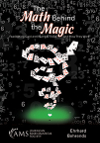- About MAA
- Membership
- MAA Publications
- Periodicals
- Blogs
- MAA Book Series
- MAA Press (an imprint of the AMS)
- MAA Notes
- MAA Reviews
- Mathematical Communication
- Information for Libraries
- Author Resources
- Advertise with MAA
- Meetings
- Competitions
- Programs
- Communities
- MAA Sections
- SIGMAA
- MAA Connect
- Students
- MAA Awards
- Awards Booklets
- Writing Awards
- Teaching Awards
- Service Awards
- Research Awards
- Lecture Awards
- Putnam Competition Individual and Team Winners
- D. E. Shaw Group AMC 8 Awards & Certificates
- Maryam Mirzakhani AMC 10 A Awards & Certificates
- Two Sigma AMC 10 B Awards & Certificates
- Jane Street AMC 12 A Awards & Certificates
- Akamai AMC 12 B Awards & Certificates
- High School Teachers
- News
You are here
The Math Behind the Magic

Buy Now:
Publisher:
AMS
Publication Date:
2019
Number of Pages:
208
Format:
Paperback
Price:
30.00
ISBN:
978-1-4704-4866-0
Category:
General
[Reviewed by , on ]
Michael Caulfield
11/9/2019
The Math Behind the Magic is a fun little book that leads the reader through a series of number and card tricks that are advanced enough so as not to be too obvious to the audience and yet simple enough for a novice magician to be able to master with practice. It was written by Ehrhard Behrends who has performed these tricks many times himself. He knows of what he speaks.
The book is broken into four main chapters, three of which are focused on tricks that can be done with playing cards. The other chapter is concerned with number tricks. The chapters, and the sections within the chapters, are independent of each other. The reader may hop from one part of the book to another, looking for items of interest, without losing the flow of the book. There is however an introductory chapter titled “Read Me!” in which the author gives foundational information such as card shuffling and cutting techniques and the properties that follow from these procedures.
All of the tricks are described using a six-part outline: a description of the trick, the preparation required, how to execute the trick, the mathematics behind the trick, suggestions for the presentation of the trick, and suggested variations of the trick. The descriptions of each of these parts are, in general, quite thorough. Even a newcomer to this world will be able to follow along and understand both how to perform the trick and why the trick works.
The book is clearly written for an audience with no assumed level of mathematical understanding. Thus the author takes the time to explain the concepts of commutativity and associativity of the natural numbers with respect to addition. However, he also provides an example of a 5 x 5 array of complex numbers that can be used in the execution of a trick using magic squares, showing that he does not limit himself to the very basic. Still, a reader without an understanding of that example can simply pass on; it is simply suggested as a possible way of performing the trick. On some occasions, more detailed mathematical explanations were relegated to an appendix or even to a paper listed in the reference section.
The suggestions for variations on the tricks were especially well done. By employing them the magician can get more mileage out of a single trick or can tailor a trick to a more sophisticated audience. The use of color photographs throughout was especially helpful. For many of the card tricks he includes multiple color photos to show the arrangement of the cards and what they should look like at different stages of the trick. This will greatly aid the understanding of the uninitiated.
As is the case with any book, the reviewer will find some minor errors or points to quibble over. For example in the trick “Fibonacci Makes Magic,” the author states that the participant may choose any pair of numbers between 1 and 7 to start the trick, but he warns the reader not to allow a starting pair of 7,7. However, the trick can still be performed in this case; it just wouldn’t be especially interesting. But the author suggests that the magician say that starting with 7,7 would be “too much good luck.” In “The Red and the Black” he proves the math behind the magic using \( \stackrel{?}{=} \), rather than the standard “start with the left side, deduce the right side” approach. Finally, in “Hummer’s Magic Trick” I found the description “the top two cards are turned face-up” ambiguous: are they turned as a pair, or individually? It took some re-reading and practice to be sure of what was meant.
These examples are included in the interest of full disclosure. But the final word is that I found this to be a very enjoyable and easy read. The explanations were almost always thorough and clear as were the suggested variations on the tricks. I fully recommend this book for anyone who is interested in learning some number and card tricks that are fairly simple to learn but that will usually leave the audience amazed.
Michael Caulfield (caulfiel001@gannon.edu) is a Professor of Mathematics at Gannon University in Erie, Pennsylvania. His writing is focused on mathematical topics of historical interest. His career in mathematics began when he was a member of an “Outstanding” team in the COMAP Mathematical Contest in Modeling.
See the publisher's web page.
- Log in to post comments




